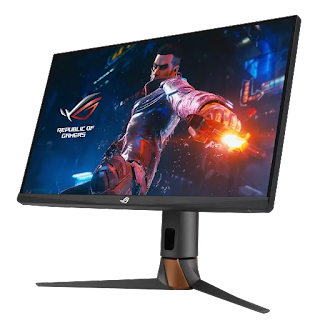For those who are active in video games, the term NVIDIA G-Sync must be familiar to you. The standard for gaming monitors that activates the adaptive feature that controls the refresh rate helps players play with the best experience. At CES 2024, NVIDIA has announced several product updates that will delight video game enthusiasts.
First of all, NVIDIA has brought G-Sync support to GeForce Now. It allows streaming video games without screen tearing issues on monitors or TVs that support G-Sync. The second point is the most interesting, because NVIDIA also introduced a new display standard named G-Sync Pulsar.
Pulsar's G-Sync will adjust the transition rate of pixels between colors to solve the problem of ghosting and blurred images when moving. This standard works according to the refresh rate support on a monitor.
This new standard can also ensure the comfort and health of the user's eyes remains good because it also adjusts the backlight flickering simultaneously while playing. This also makes the display non-flickering which makes the player dizzy. For now according to NVIDIA, only the ASUS ROG Swift PG27 series has received this standard.
At the same time, NVIDIA also announced that this year there will be 24 monitors and televisions recognized with the G-Sync standard. They work with Alienware, AOC, ASUS, Dough, IO Data, LG, Philips, Thermaltake, and ViewSonic. Each of these display products will support G-Sync e-sports mode as well as HDR display with G-Sync Ultimate.
The following are among the products launched;
Brand Model Size Panel Type Resolution Refresh Rate
Alienware AW3225QF 32 OLED 3840×2160 (4K) 240Hz
ASUS ROG Swift PG27 series 27 IPS 2560×1440 (QHD) 360Hz
PG49WCD 49 OLED 5140×1440 (DQHD) 144Hz
AOC 16G3 16 IPS 1920×1080 (FHD) 144Hz
24G4 24 IPS 1920×1080 (FHD) 165Hz
27G4 27 IPS 1920×1080 (FHD)
PD49 49 OLED 5120×1440 (DQHD) 240Hz
Q27G2SD 27 IPS 2560×1440 (QHD) 180Hz
Dough ES07E2D 27 OLED 2560×1440 (QHD) 240Hz
IO Data GCU271HXA 27 IPS 3840×2160 (4K) 160Hz
LG 2024 4K M4 / G4 97 OLED 3840×2160 (4K) 120Hz
2024 4K M4 / G4 83, 77, 65, 55 OLED 3840×2160 (4K) 144Hz
2024 4K C4 series 83, 77, 65, 55, 48, 42 OLED 3840×2160 (4K)
2024 4K CS series 65, 55 OLED 3840×2160 (4K) 120Hz
2024 4K B4 series 77, 65, 55, 48 OLED 3840×2160 (4K)
24G560F 24 IPS 1920×1080 (FHD) 180Hz
27G560F 27 IPS 1920×1080 (FHD)
27GR75QB 27 IPS 2560×1440 (QHD) 144Hz
32GP75A 32 IPS 2560×1440 (QHD) 165Hz
Philips 25M2N3200 25 IPS 1920×1080 (FHD) 180Hz
27M1N5500P 27 IPS 2560×1440 (QHD) 240Hz
49M2C8900 49 OLED 5120×1440 (DQHD)
Thermaltake 27FTQB 27 IPS 2560×1440 (QHD) 165Hz
ViewSonic XG272-2K-OLED 27 OLED 2560×1440 (QHD) 240Hz
For now the price and sale date are still not announced. So is the presence for the local market. Let's all look forward to further developments on these 24 NVIDIA recognized display products.

